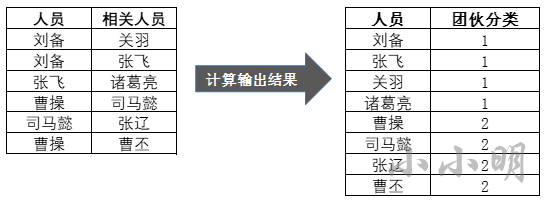前文回顾:
PySpark与GraphFrames的安装与使用
https://xxmdmst.blog.csdn.net/article/details/123009617networkx快速解决连通图问题
https://xxmdmst.blog.csdn.net/article/details/123012333
前面我讲解了PySpark图计算库的使用以及纯python解决连通图问题的两个示例。这篇文章我们继续对上次的连通图问题改用PySpark实现。
需求1:找社区
刘备和关羽有关系,说明他们是一个社区,刘备和张飞也有关系,那么刘备、关羽、张飞归为一个社区,以此类推。

对于这个连通图问题使用Pyspark如何解决呢?
首先,我们创建spark对象:
from pyspark.sql import SparkSession, Row
from graphframes import GraphFrame
spark = SparkSession \
.builder \
.appName("PySpark") \
.master("local[*]") \
.getOrCreate()
sc = spark.sparkContext
# 设置检查点目录
sc.setCheckpointDir("checkpoint")
然后构建数据:
data = [
['刘备', '关羽'],
['刘备', '张飞'],
['张飞', '诸葛亮'],
['曹操', '司马懿'],
['司马懿', '张辽'],
['曹操', '曹丕']
]
data = spark.createDataFrame(data, ["人员", "相关人员"])
data.show()
+------+--------+
| 人员|相关人员|
+------+--------+
| 刘备| 关羽|
| 刘备| 张飞|
| 张飞| 诸葛亮|
| 曹操| 司马懿|
|司马懿| 张辽|
| 曹操| 曹丕|
+------+--------+
很明显原始数据就是图计算所要求的边数据,只修改一下列名即可:
edges = data.toDF("src", "dst")
edges.printSchema()
root
|-- src: string (nullable = true)
|-- dst: string (nullable = true)
下面我们开始构建顶点数据:
vertices = (
edges.rdd.flatMap(lambda x: x)
.distinct()
.map(lambda x: Row(x))
.toDF(["id"])
)
vertices.show()
+------+
| id|
+------+
|诸葛亮|
| 刘备|
| 曹操|
|司马懿|
| 曹丕|
| 关羽|
| 张飞|
| 张辽|
+------+
下面使用spark的图计算 计算连通图:
g = GraphFrame(vertices, edges)
result = g.connectedComponents().orderBy("component")
result.show()
+------+------------+
| id| component|
+------+------------+
|司马懿| 0|
| 张辽| 0|
| 曹丕| 0|
| 曹操| 0|
| 关羽|635655159808|
| 刘备|635655159808|
| 张飞|635655159808|
|诸葛亮|635655159808|
+------+------------+
可以看到结果中已经顺利将一个社区的成员通过一个相同的component标识出来,成功解决需求。
需求2:统一用户识别
abcde这5个字段表示mac地址,ip地址,device_id,imei等唯一标识,tags表示用户的标签。由于某些原因,同一用户的唯一标识字段总是有几个字段存在缺失,现在要求将同一个用户的数据都能识别出来,同时将每个用户的标签进行合并。原始数据和结果模型示例如下:

首先,我们构建数据:
df = spark.createDataFrame([
['a1', None, 'c1', None, None, 'tag1'],
[None, None, 'c1', 'd1', None, 'tag2'],
[None, 'b1', None, 'd1', None, 'tag3'],
[None, 'b1', 'c1', 'd1', 'e1', 'tag4'],
['a2', 'b2', None, None, None, 'tag1'],
[None, 'b4', 'c4', None, 'e4', 'tag1'],
['a2', None, None, 'd2', None, 'tag2'],
[None, None, 'c2', 'd2', None, 'tag3'],
[None, 'b3', None, None, 'e3', 'tag1'],
[None, None, 'c3', None, 'e3', 'tag2'],
], list("abcde")+["tags"])
df.show()
结果:
+----+----+----+----+----+----+
| a| b| c| d| e|tags|
+----+----+----+----+----+----+
| a1|null| c1|null|null|tag1|
|null|null| c1| d1|null|tag2|
|null| b1|null| d1|null|tag3|
|null| b1| c1| d1| e1|tag4|
| a2| b2|null|null|null|tag1|
|null| b4| c4|null| e4|tag1|
| a2|null|null| d2|null|tag2|
|null|null| c2| d2|null|tag3|
|null| b3|null|null| e3|tag1|
|null|null| c3|null| e3|tag2|
+----+----+----+----+----+----+
接下来的思路依然跟上次一样,首先为每一行数据分配一个唯一id,然后对每个唯一标识的列,根据是否一样构建行与行之间的连接关系,所有的唯一标识列产生的连接关系共同作为图计算的边。
下面使用RDD的zipWithUniqueId方法为每一行产生一个唯一ID,并将这个ID移动到最前(由于这个数据后面可能会多次被频繁使用所以缓存起来):
tmp = df.rdd.zipWithUniqueId().map(lambda x: (x[1], x[0]))
tmp.cache()
tmp.first()
(0, Row(a='a1', b=None, c='c1', d=None, e=None, tags='tag1'))
根据唯一id构建顶点数据:
vertices = tmp.map(lambda x: Row(x[0])).toDF(["id"])
vertices.show()
+---+
| id|
+---+
| 0|
| 1|
| 7|
| 2|
| 8|
| 3|
| 4|
| 10|
| 5|
| 11|
+---+
接下来,构建边数据:
def func(p):
for k, ids in p:
ids = list(ids)
n = len(ids)
if n <= 1:
continue
for i in range(n-1):
for j in range(i+1, n):
yield (ids[i], ids[j])
edges = []
keylist = list("abcde")
for key in keylist:
data = tmp.mapPartitions(lambda area: [(row[key], i) for i, row in area if row[key]])
edgeRDD = data.groupByKey().mapPartitions(func)
edges.append(edgeRDD)
edgesDF = sc.union(edges).toDF(["src", "dst"])
edgesDF.cache()
edgesDF.show()
+---+---+
|src|dst|
+---+---+
| 8| 4|
| 7| 2|
| 0| 1|
| 0| 2|
| 1| 2|
| 4| 10|
| 1| 7|
| 1| 2|
| 7| 2|
| 5| 11|
+---+---+
可以看到所有的行号关系已经被成功获取。
下面使用图计算 计算出属于同一用户的行:
gdf = GraphFrame(vertices, edgesDF)
components = gdf.connectedComponents()
components.show()
+---+---------+
| id|component|
+---+---------+
| 0| 0|
| 1| 0|
| 7| 0|
| 2| 0|
| 8| 4|
| 3| 3|
| 4| 4|
| 10| 4|
| 5| 5|
| 11| 5|
+---+---------+
有了行号和所归属的组唯一标识,我们可以通过表连接获取原始数据的每一行所归属的component:
result = tmp.cogroup(components.rdd) \
.map(lambda pair: pair[1][0].data[0] + Row(pair[1][1].data[0])) \
.toDF(df.schema.names+["component"])
result.cache()
result.show()
+----+----+----+----+----+----+---------+
| a| b| c| d| e|tags|component|
+----+----+----+----+----+----+---------+
| a1|null| c1|null|null|tag1| 0|
|null|null| c1| d1|null|tag2| 0|
|null| b1| c1| d1| e1|tag4| 0|
|null| b4| c4|null| e4|tag1| 3|
| a2|null|null| d2|null|tag2| 4|
|null| b3|null|null| e3|tag1| 5|
|null| b1|null| d1|null|tag3| 0|
| a2| b2|null|null|null|tag1| 4|
|null|null| c2| d2|null|tag3| 4|
|null|null| c3|null| e3|tag2| 5|
+----+----+----+----+----+----+---------+
可以看到我们已经成功的进行同一用户识别了,剩下的只需要分组并使用pandas的逻辑合并数据:
def func(pdf):
row = pdf[keylist].bfill().head(1)
row["tags"] = pdf.tags.str.cat(sep=",")
return row
result.groupBy("component").applyInPandas(
func, schema="a string, b string, c string, d string, e string, tags string"
).show()
+----+---+---+----+----+-------------------+
| a| b| c| d| e| tags|
+----+---+---+----+----+-------------------+
| a1| b1| c1| d1| e1|tag1,tag2,tag4,tag3|
|null| b4| c4|null| e4| tag1|
| a2| b2| c2| d2|null| tag2,tag1,tag3|
|null| b3| c3|null| e3| tag1,tag2|
+----+---+---+----+----+-------------------+
可以看到已经顺利得到需要的结果。
注意:applyInPandas要求返回的结果必须是pandas的datafream对象,所以相对之前的逻辑由.iloc[0]改成了.head(1)
如果你的spark不是3.X版本,没有applyInPandas方法,用原生rdd的方法则会麻烦很多:
def func(pair):
component, rows = pair
keyList = list("abcde")
ids = {
}
for row in rows:
for key in keylist:
v = getattr(row, key)
if v:
ids[key] = v
ids.setdefault("tags", []).append(row.tags)
result = []
for key in keylist:
result.append(ids.get(key))
result.append(",".join(ids["tags"]))
return result
result2 = result.rdd.groupBy(
lambda row: row.component).map(func).toDF(df.schema)
result2.cache()
result2.show()
结果也一样:
+----+---+---+----+----+-------------------+
| a| b| c| d| e| tags|
+----+---+---+----+----+-------------------+
| a1| b1| c1| d1| e1|tag1,tag2,tag4,tag3|
|null| b4| c4|null| e4| tag1|
| a2| b2| c2| d2|null| tag2,tag1,tag3|
|null| b3| c3|null| e3| tag1,tag2|
+----+---+---+----+----+-------------------+